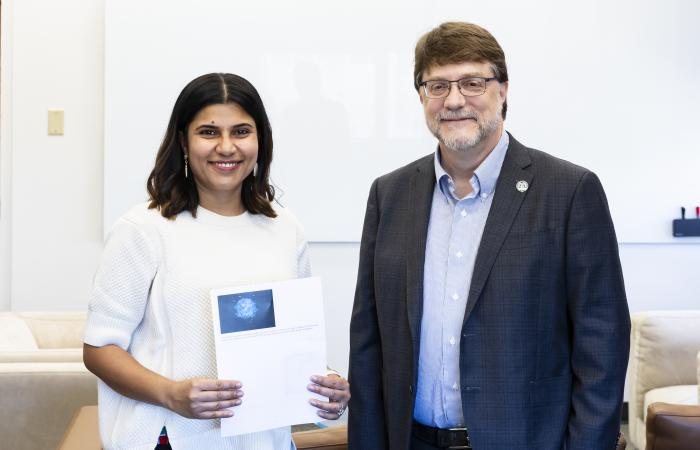The photo of “Three-Dimensional Breast Cancer Spheroids” submitted by radiotherapeutics researcher Debjani Pal is stunning. Brilliant blue dots pop from an electric sphere threaded with bright colors: greens, aqua, hot pink and red.
The slice from an image of breast cancer tissue, viewed under a confocal microscope, shows a nanobody (the green lines) affecting the HER2 genetic cancer marker in a sample with both HER2-positive and HER2-negative breast cancer cells.
The image was captivating enough to win Pal the Director’s Choice Award in Oak Ridge National Laboratory’s Art of Science photo competition. Her photo, and those of 19 other finalists — including “People’s Choice” award winner Subhamay Pramanik of the Physical Sciences Directorate — will be displayed at the American Museum of Science and Energy in Oak Ridge, Tenn., in coming months.
But Pal, a research and development associate in the Isotope Science and Engineering Directorate’s Radioisotope Science and Technology Division, has her eye on something even more beautiful: an eventual cure for cancer.
A biochemist, Pal has devoted her career to gaining a better understanding of cancer biology — specifically, the link between certain biologics and how they trigger or suppress the proliferation of cancer cells.
In Pal’s first postdoctoral fellowship, at the Ohio State University Comprehensive Cancer Center, she focused on two specific projects involving intracellular processes related to cancer cell replication: dissecting E3 ubiquitin ligase, Anaphase Promoting Complex/Cyclosome (APC/C) role in glioblastoma stem cells and delineating the effects of the USP37-Chk1-Axis on the regulation of G1/S transition via the tumor suppressor form of the APC/C, APC/CCdh1.
But shortly afterward, she turned her focus to developing radiolabeled nanotechnology-based agents to fight cancer.
Last year, Pal was on a team that received wide acclaim for discovering certain genes that trigger uncontrolled cell growth and eventually lead to specific kinds of cancers.
The researchers found that a unique domain — plasminogen-apple-nematode, or PAN — was linked to more than 28,000 proteins, including HGF, a well-known biomarker. When paired with the MET receptor, HGF activates a signaling cascade that triggers cell movement, tissue regeneration and the formation of new blood vessels.
Altering specific amino acids in the PAN domain of HGF/MET reduced cancer cell proliferation — a discovery that could contribute to the development of targeted drug therapies to fight various cancers, including harder-to-treat breast and stomach cancers, that have limited effects on surrounding, healthy tissue. The work was published in Communications Biology.
The groundbreaking nature of Pal’s cancer research has generated wide interest and numerous media highlights. Notably, the Department of Energy highlighted her research in “Basic to Breakthrough,” which selects the best research from among national laboratories and university labs, and for President Biden’s Cancer Moonshot program.
This year, Pal produced another insightful work on the possible entry mechanism of the COVID-19 spike protein, possibly informing future treatment. Pal discovered novel cysteine residues present on the Neuropilin-1 extracellular domain that directly binds with the spike protein and showed that mutating these novel residues significantly downregulates the spike protein internalization. This considerably reduced spike protein abundance in cells for the original, alpha and delta SARS-CoV-2 variants. Her study reveals that targeting Neuropilin-1 can be highly effective and has the potential to be considered as a path in treating severe SARS-CoV-2 infection. The work was published in iScience journal and highlighted by DOE’s Office of Science.
“Most of the available therapeutics against COVID-19 target the viral spike protein by inhibiting its binding to the receptor,” Pal said. “Unfortunately, the spike proteins continuously mutate, defining the impact of vaccine efficiency. Our work showed that the significant retardation of binding between the spike protein and the receptor could be achievable just by mutating the receptor, and it works for different SARS-CoV-2 variants.”
Pal worked with plant proteins during her graduate studies, using radiolabeled proteins to investigate the mechanics of a certain system in the part of the plant in which photosynthesis happens. Though her research can be applied to grow better plants for biofuel production, her primary interest was in its possible application to medical treatments.
“I can work with equal efficiency in plant and human cancers. The expertise is the same,” Pal told the Oak Ridger last year. “We’ve established a globalized experimental platform here at ORNL that shows no matter what system you’re using, plant or animal, if your hypothesis is correct then the science is repeatable in all of them, no matter what cell line you’re using.”
Pal joined ISED’s Isotope Applications Research group full time in 2022 after holding a postdoctoral research associate position in the Biological and Environmental Systems Science Directorate. She holds an honors bachelor of science in microbiology with chemistry and physics and a master of science in microbiology from the University of Calcutta, Kolkata, India, where she also served as a lecturer in microbiology, biochemistry and molecular biology. She earned her doctorate in protein biochemistry from Miami University in Oxford, Ohio.
ORNL is managed by UT-Battelle for DOE’s Office of Science, the single largest supporter of basic research in the physical sciences in the United States. DOE’s Office of Science is working to address some of the most pressing challenges of our time. For more information, visit energy.gov/science.





